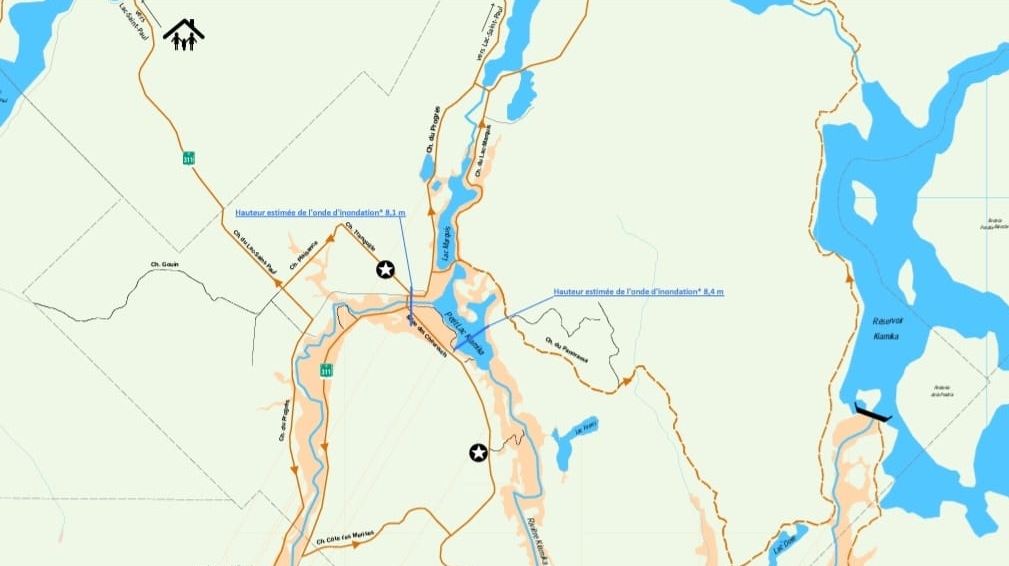No return date for 700 Quebecers evacuated because of fears dike could burst
 People living in Chute-Saint-Philippe and Lac-des-Écorces are being asked to evacuate their homes due to potential infrastructure issues at the Kiamika dam and Morier dike. (Credit: Municipality of Chute-Saint-Philippe)
People living in Chute-Saint-Philippe and Lac-des-Écorces are being asked to evacuate their homes due to potential infrastructure issues at the Kiamika dam and Morier dike. (Credit: Municipality of Chute-Saint-Philippe)
It's unclear when about 700 people can return to their properties in Quebec's Laurentians region after they were forced out earlier this week because of fears a dike on a nearby river could fail, Public Security Minister Francois Bonnardel said Tuesday.
Authorities are planning to start repair work by this weekend or early next week on the dike -- whose reservoir can retain up to 382 million cubic metres of water, the equivalent of more than 100,000 Olympic-size swimming pools. Flood maps show that up to 2,000 buildings could be impacted if the dike bursts, and parts of the area could suffer landslides, officials said.
"It would be inadequate to fix a return date … we don't know what could happen, (including) additional surprises," Bonnardel told a news conference.
The Public Security Department ordered hundreds of residents to evacuate Sunday from the municipalities of Chute-St-Philippe, Lac-des-Ecorces and Lac-Saguay. The three communities are located close to each other by the Kiamika River, and about 125 kilometres northeast of Ottawa.
Bonnardel, who visited civil security officials and displaced residents on Tuesday, said the vast majority of people are staying with family or friends outside the region, adding that about 145 of them are housed in hotels or inns in the area. He reassured residents and affected municipalities there would be financial help from the provincial government.
Martin Ferland, an engineer with the Environment Department, said the province built a road on Monday for heavy machinery to access the Morier dike, which was built in 1954 and is owned by the government. Teams were working hard to reduce the risk of a breach and were evaluating the situation, he said.
In the short term, the dike will be fitted with a reverse filter to catch water seepage from parts of the structure that are eroded, Ferland said. By the end of the week or early next week, he added, construction will begin on a berm to divert water and stabilize the dike. A new hydrometric station will be installed Wednesday to monitor water levels, and drones will be flown to monitor the area.
Roughly 2,000 buildings could be impacted, according to flood maps. Ferland said the area at risk of flooding includes buildings of all kinds, homes, and roads, adding that parts of the region are at risk of landslides.
"There aren't entire towns, but important zones that could be flooded," Ferland said. "The level of flooding is variable according to the sectors, the topography, the conditions after a rupture."
During the most recent monthly inspection, officials found structural weaknesses in the Morier dike that could lead it to burst. Authorities suspect internal erosion to be the cause of the structural damage.
-- This report by The Canadian Press was first published Dec. 5, 2023.
CTVNews.ca Top Stories

LIVE UPDATES Critical infrastructure 'successfully protected': Jasper park officials
Jasper National Park officials in an update said all critical infrastructure in the townsite has been 'successfully protected, including the hospital, emergency services building, both elementary and junior/senior schools, activity centre and wastewater treatment plant.'
Canadian Olympic Committee removes women's soccer team's head coach over drone scandal
The Canadian Olympic Committee has removed women's national soccer team head coach Bev Priestman over a drone scandal, according to a press release from the organization.
Yukon woman narrowly escapes bear attack, credits hair clip
A woman in Yukon believes her hair clip helped save her during a bear attack.
Prince William's 2023 salary revealed in new report
Newly released financial reports show that William, the Prince of Wales, drew a salary of $42.1 million last fiscal year, his first since inheriting the vast and lucrative Duchy of Cornwall.
'I was just shocked': Jasper lodge owner on seeing property destroyed by wildfire
On Wednesday night, the owner of Maligne Lodge in Jasper, Alta., was shocked to receive a photo of her business engulfed in flames.
Mary-Ellen Turpel-Lafond likely has Indigenous DNA: report
The Law Society of British Columbia says a DNA test shows a former judge and Order of Canada recipient accused of falsely claiming to be Cree "most likely" has Indigenous heritage.
U.S. authorities have arrested 'El Mayo' Zambada, a historic leader of Mexico's Sinaloa cartel
Ismael 'El Mayo' Zambada, a historic leader of Mexico's Sinaloa cartel, and Joaquin Guzman Lopez, a son of another infamous cartel leader, were arrested by U.S. authorities in Texas on Thursday, the U.S. Justice Department said.
Harris pushes Netanyahu to ease suffering in Gaza: 'I will not be silent'
U.S. Vice President Kamala Harris pressured Israeli Prime Minister Benjamin Netanyahu on Thursday to help reach a Gaza ceasefire deal that would ease the suffering of Palestinian civilians, striking a tougher tone than President Joe Biden.
'She led it the whole way': 18-year-old B.C. woman leads hikers to safety in Jasper National Park
As fire threatened people in Jasper National Park, Colleen Knull sprung into action.

































